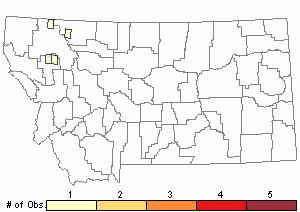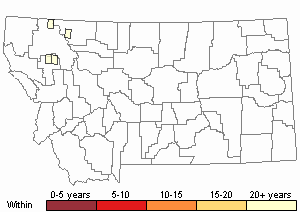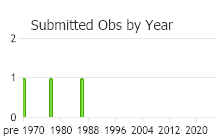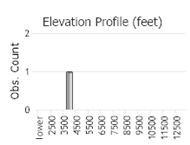View in other NatureServe Network Field Guides
NatureServe
Montana
Utah
Wyoming
Idaho
Wisconsin
British Columbia
South Carolina
Yukon
California
New York
A Tortella Moss - Tortula subulata
General Description
Plants: Acrocarpous (Vitt 1988). Growing in loose to somewhat dense, upright clumps (Lawton 1971), green or deep green above, ochre or deep brown below (FNA 2007). Stems mostly 5-10 cm tall (Lawton 1971); possessing a central strand (FNA 2007).
Leaves: Twisted and erratically curved when dry, spreading somewhat when wet, 3-5 mm in length, 0.8-1.2 mm in width (Lawton 1971), lance-shaped tending toward rectangular or elliptical and a little stretched; margins curved out and downward below (FNA 2007), smooth, sometimes minutely saw-toothed at the tip; costa shiny and prominent especially when dry, protruding beyond the apex to form a short mucro (Lawton 1971), faintly keeled on the ventral surface (FNA 2007).
Leaf Cells: Margins with a uni- or bi-stratose border (Lawton 1971) running throughout or restricted to the lower 2/3 and consisting of 3-5 rows of elongated cells (1-3:1) with relatively thicker walls; upper laminal cells 1:1, the 6 sides rounded, each with 4-5 bi-lobed papillae; basal cells rectangular and fine-walled; costa with hydroid strand, dorsal stereid band (FNA 2007), and 2-4 guide cells (Lawton 1971).
Phenology
Fruit ripens spring through the first part of summer (FNA 2007).
Range Comments
North American Range
In western Canada (BC and AB) and (mostly) the western continental US (WA, OR, CA, MT, UT, CO and IL) (FNA 2007). Known in Montana from Cascade, Flathead, Glacier and Lake Counties (Elliott 2016).
Observations in Montana Natural Heritage Program Database
Number of Observations: 4
(Click on the following maps and charts to see full sized version)
Map Help and Descriptions
Relative Density

Recency



 (Observations spanning multiple months or years are excluded from time charts)
(Observations spanning multiple months or years are excluded from time charts)
Habitat
Soil (Elliott 2016). Elevation low to medium (FNA 2007).
Reproductive Characteristics
Autoicous. Seta 1-3 cm, carrying the capsule well beyond the perichaetial bracts. Capsule vertical and nearly straight, the theca 4-6 mm in length (FNA 2007); peristome red, papillose (Lawton 1971), with teeth of 32 filaments spiraled 1 full revolution or more (FNA 2007).
Stewardship Responsibility
References
- Literature Cited AboveLegend:
 View Online Publication
View Online Publication Elliott, J.C. and A.K. Pipp. 2018. A Checklist of Montana Mosses (1880-2018). Updated 3 January, 2020. Montana Natural Heritage Program, Helena, Montana. 73 pp.
Elliott, J.C. and A.K. Pipp. 2018. A Checklist of Montana Mosses (1880-2018). Updated 3 January, 2020. Montana Natural Heritage Program, Helena, Montana. 73 pp. Flora of North America Editorial Committee, eds. 2007. Flora of North America North of Mexico. Volume 27. Bryophytes: Mosses, Part 1. Oxford University Press, Inc., NY. xxi + 713 pp.
Flora of North America Editorial Committee, eds. 2007. Flora of North America North of Mexico. Volume 27. Bryophytes: Mosses, Part 1. Oxford University Press, Inc., NY. xxi + 713 pp. Lawton, E. 1971. Moss Flora of the Pacific Northwest. Hattori Botanical Laboratory. Japan: Yamabuki-cho, Shinjuku-ku, Tokyo. 362 pages plus appendices.
Lawton, E. 1971. Moss Flora of the Pacific Northwest. Hattori Botanical Laboratory. Japan: Yamabuki-cho, Shinjuku-ku, Tokyo. 362 pages plus appendices. Vitt, D. J. Marsh, and R. Bovey. 1988. Mosses, Lichens & Ferns of Northwest North America. Seattle, WA: University of Washington Press. 296 p.
Vitt, D. J. Marsh, and R. Bovey. 1988. Mosses, Lichens & Ferns of Northwest North America. Seattle, WA: University of Washington Press. 296 p.
- Additional ReferencesLegend:
 View Online Publication
View Online Publication
Do you know of a citation we're missing? Elliot, J. C. 1993. Second checklist of Montana mosses. Unpublished report. U.S. Forest Service, Region 1. Missoula, MT. 45 pp.
Elliot, J. C. 1993. Second checklist of Montana mosses. Unpublished report. U.S. Forest Service, Region 1. Missoula, MT. 45 pp. Lawton, E. 1971. Keys for the Identification of the Mosses on the Pacific Northwest. Reprinted from 'Moss Flora of the Pacific Northwest'. Published as Supplement No. 2 of the Journal of the Hattori Botanical Laboratory. Nichinan, Miyazaki, Japan. 66 pp.
Lawton, E. 1971. Keys for the Identification of the Mosses on the Pacific Northwest. Reprinted from 'Moss Flora of the Pacific Northwest'. Published as Supplement No. 2 of the Journal of the Hattori Botanical Laboratory. Nichinan, Miyazaki, Japan. 66 pp. Malcolm, B., N. Malcolm, J. Shevock, and D. Norris. 2009. California Mosses. Nelson, New Zealand: Micro-Optics Press. 430 pp.
Malcolm, B., N. Malcolm, J. Shevock, and D. Norris. 2009. California Mosses. Nelson, New Zealand: Micro-Optics Press. 430 pp. Smith, A.J.E. 1980. The Moss Flora of Britain and Ireland. Cambridge University Press, Cambridge. 705 pp.
Smith, A.J.E. 1980. The Moss Flora of Britain and Ireland. Cambridge University Press, Cambridge. 705 pp.
- Web Search Engines for Articles on "A Tortella Moss"





